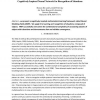597 search results - page 22 / 120 » Combinatorial Models for Cooperation Networks |
BPM
2005
Springer
14 years 2 months ago
2005
Springer
Scientific experiments are supported by activities that create, use, communicate and distribute information whose organizational dynamics is similar to processes performed by distr...
IJNCR
2010
13 years 6 months ago
2010
we present a cognitively inspired mathematical learning framework called Neural Modeling Fields (NMF). We apply it to learning and recognition of situations composed of objects. NM...
WMCSA
2002
IEEE
14 years 1 months ago
2002
IEEE
MOPED (MObile grouPEd Device) is a network model that treats a user’s set of personal devices as a single, virtual device. The nodes of the MOPED dynamically aggregate available...
GECCO
2005
Springer
14 years 2 months ago
2005
Springer
This article describes a mathematical framework for characterizing cooperativity in complex systems subject to evolutionary pressures. This framework uses three foundational compo...
KI
2010
Springer
13 years 6 months ago
2010
Springer
Recognizing human intentions is part of the decision process in many technical devices. In order to achieve natural interaction, the required estimation quality and the used comput...

